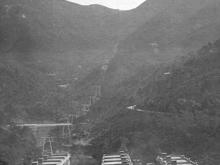MEDICAL CORNER: CAULIFLOWER EARS, OPIUM AND ERROL FLYNN
Primary tabs
This first appeared in issue #2 of 'History Notes', compiled by the late Phillip Bruce. It is reproduced here on Gwulo by kind permission of Mr Bruce's family.
By Dr D. Owens, MB, and Dr M.J. Humphries, MRCP. Ruttonjee Sanatorim
Summary:
The appearance of cauliflower ears in elderly Chinese patients may indicate a history of opium abuse. The patient presented here is one of several in whom we have noted this physical sign of historical interest and occasional clinical usefulness.
Case Report:
The patient is an 81-year-old Chinese gentleman admitted to hospital for management of pulmonary tuberculosis and renal failure. He was born in the city of Canton in southern China in 1907 during the final years of the Ching Dynasty. He received no formal education and began working as a labourer during his childhood. His father, grandfather and most of their male friends and relatives regularly took opium. It was unusual for women to smoke opium at that time and his mother abstained.
The patient began to use opium regularly at the age of 20 and quickly became addicted, smoking two pipes daily for most of his life. Opium would be smoked in one of the many dens which were often built of stone and were furnished with several wooden or stone beds.
Opium was freely available and could be bought either in the dens or from street sellers. At that time opium was sold in the form of a black paste which was stored in jars and could be bought by the scoop. In the 1920s each pipe of opium would cost the equivalent of one quarter of a coolie’s daily income. The expense of the patient's addiction is the reason he gives for never having married. In the early 1930s, the patient moved to Hong Kong where he continued to take opium regularly, finally giving up the habit at the age of 70 because of frequent arrests by the Royal Hong Kong Police.
The patient gave no past history of contact sport such as boxing or rugby football, or other activities likely to lead to auricular trauma. On examination, bilateral swollen and mishapen auricles, or cauliflower ears, were observed. The remainder of the physical examination was non-contributary.
Discussion:
In the eighteenth century, trade between China and Great Britain was active. The protectionist policy of the Chinese administration ensured that tea and silk were exchanged only for silver and gold. In an attempt to correct the resulting trade deficit the British began to transport opium from Bengal to China. The opium trade boomed and opium usage increased rapidly.
In 1838 Emperor Dau Kuang was alarmed at the growing numbers of addicts and attempted to crush the opium trade, large amounts of opium were confiscated and burned in open pits. It was the political consequences of this action and the subsequent war which resulted in the British occupation and colonisation of Hong Kong in 1841.
Throughout the next century opium remained freely available. Although the opium trade eventually ceased, the trafficking and possession of opiates was not made illegal in Hong Kong until 1946.
As a result of such recent widespread opiate abuse there is a population of elderly addicts who may have been taking opiates in one form or another for 50 years or more. Indeed, of the population of known drug addicts in Hong Kong reported from 1977 to 1986, 35.5 per cent were aged 50 years or more (The Hong Kong Action Committee Against Narcotics, Annual Report 1986:87) Being called upon to chastise an octogenarian who has foresaken his zimmer-frame to 'chase the dragon' or 'meet the Emperor' in the ward toilet is an occasional part of hospital life. A significant number of such patients have cauliflower ears.
An earlier report of the association between opium abuse and auricular trauma can be found in the autobiography of the Hollywood filmstar Errol Flynn (Flynn, Errol. My Wicked, Wicked Ways. Pan Books, London 1961:136). During a visit to Hong Kong in 1932 Flynn described a brief encounter with Ting Ling, a female companion who surprised him by her ability to correctly identify opium addicts by the abnormal shape of one or both ears. She attributed her skill to the recognition of swollen, misshapen auricles which resulted from long periods of opium-induced slumber while laying on opium beds with hard wooden pillows, common to the opium dens at that time.
Since then the pattern of opiate abuse in Hong Kong has changed. In earlier years nearly all addicts smoked opium whereas less than one per cent of the current population of addicts do so. The opium dens are no longer in existence and 96 percent of addicts now use heroin, either by injection or by fume inhalation, otherwise known as 'chasing the dragon'.
There are many implications of the changing methods of drug abuse in any society. It is probable that one such effect will be a decline in the incidence of cauliflower ears amongst drug addicts in Hong Kong.

